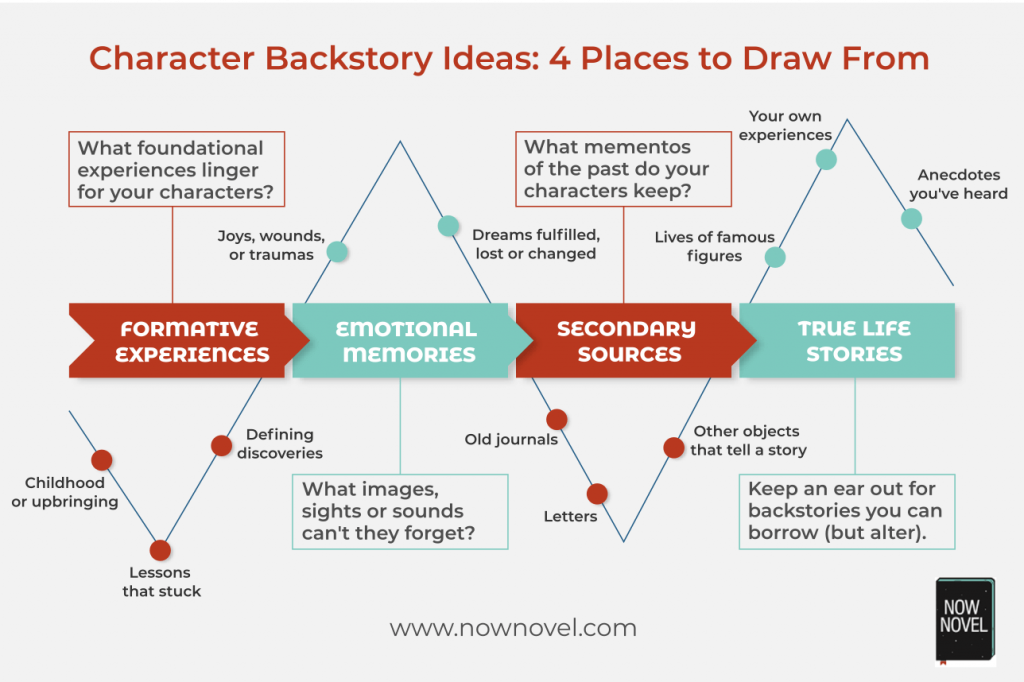Learning how to write character background or compelling backstory requires balancing present and past narration. Read 7 tips to write better backstory:
7 character background story ideas:
- Brainstorm formative events that shape your characters
- Choose where to tell character backstory
- Balance telling backstory with showing
- Keep backstory relevant to current choices and actions
- Strip excess backstory from narration
- Use backstory to reveal drives
- Draw character background from familiar places
1. Brainstorm formative events that shape your characters
What is backstory? The simplest backstory definition is ‘a history or background created for a fictional character’ (OED). Backstory is a synonym for ‘character history’ in a way. It’s the web of formative experiences that help to explain your characters’ desires, fears and motivations.
Every time you create a new character, think about their history. What could explain the way they are now?
Tweet This
For example, if your character is extremely competitive, what past experiences could have shaped this approach to life? Consider these events below that may have contributed to their character development.
Perhaps your character:
- Grew up in a large family where siblings were always competing for attention and/or acknowledgment
- Was raised by parents who imprinted specific world views (e.g. ‘You have to be the best to succeed’)
- Failed in the past in something they badly wanted to succeed in, making them urgently want to not repeat painful past experiences
Once you have an idea of the earlier experiences that drive your characters, you can use these backstory ideas to craft scenes that show the impact of your characters’ histories.
For example, you might decide to show a character whose competitive nature was formed in sibling rivalries going home for the holidays where these old rivalries will resurface in an explosive family argument.
2. Choose where to tell character backstory
There are several ways to reveal character backstories.
Firstly, you could simple ‘tell’ backstory. A basic example of this type of backstory is the ‘Once upon a time…’ used in fairy tales.
Lumping all your backstory in your exposition is risky, though. Too much telling up front may be overwhelming to your reader.
Balance giving some backstory upfront with gradually revealing characters’ foundations. It’s not always bad to tell the reader (rather than show) a character’s past. In epic fantasy novels, for example, prologues often give readers context for current events. In this case, telling backstory could seem the most efficient way to clarify how the past lives on in the present.

Create a vivid cast of characters
Profile and outline characters in Now Novel’s easy, step by step dashboard.
Learn MoreExample of effective ‘telling’ backstory: David Copperfield
Charles Dickens opens David Copperfield with expository backstory, yet he avoids bland info-dumping:
I was a posthumous child. My father’s eyes had closed upon the light of this world six months, when mine opened on it. There is something strange to me, even now, in the reflection that he never saw me; and something stranger yet in the shadowy remembrance that I have of my first childish associations with his white grave-stone in the churchyard, and of the indefinable compassion I used to feel for it lying out alone there in the dark night, when our little parlour was warm and bright with fire and candle […]
Dickens, David Copperfield (1850), p. 1.
The backstory here gives context for story development (David is sent away when his mother eventually remarries, unhappy partially due to his loyalty to his late father).
Even though told via exposition, Dickens keeps David’s backstory interesting by including emotional description. Such as the loneliness implied by the metaphor describing David’s father’s gravestone as ‘locked out’ of the warmly lit house.
Other pointers to note: include their cultural background, their education, or even economic status. This can also assist you with describing the time period that your character lives in. Explore both the family and personal history of your character. What key moments shaped your character when growing up, for example? Create a childhood backstory.

3. Balance telling backstory with showing
To keep character backstory given upfront from becoming an info dump, keep some information to reveal gradually.
You could reveal details about characters’ pasts using:
- Dialogue. Characters share intimate or revealing details of their pasts with each other as it becomes relevant to their unfolding experiences
- Flashbacks. An experience or encounter triggers vivid recollection
- Parallel time frames. A character’s story unfolds alongside an earlier time setting that shows a character’s past as it unfolded
Because there are so many different ways to write character backstory, it’s easy to balance characters’ backgrounds with their present lives without info-dumping.
For example, in one piece of dialogue your character might reveal a difficult relationship with a parent. In another scene, an event (such as the parent being admitted to hospital) could trigger a memory that deepens the reader’s understanding of this relationship.
Spreading out the events that happened earlier in characters’ lives this way makes it easy to build backstory subtly. Unlike an info-dump, this balances earlier events with narration that describes the ‘here and now’ of your characters’ present lives.
4. Keep backstory relevant to current choices and actions
When writing character backstory, ‘relevance’ is key. Any event you describe in detail from your character’s past needs to be relevant to (i.e. needs to have an impact on) later developments.
For example, in J.K. Rowling’s Harry Potter series, the villain has killed Harry’s parents long before the story opens.
This dramatic event in this backstory helps to explain the protagonist’s complete commitment to defeating and confronting the series’ villain, even though they appear overwhelmingly dangerous. The is a major emotional driver behind this quest.
Example of relevant backstory: Raskolnikov’s essay in Crime and Punishment
Backstory doesn’t have to show cause and effect this explicitly. For example, in Dostoevsky’s Crime and Punishment, the protagonist Raskolnikov murders a pawnbroker whose cutthroat lending practices he sees as a great source of misery in the world.
We later learn that the murderous anti-hero wrote an essay as a student arguing that people who take actions that benefit society as a whole should be above the law.
This piece of backstory doesn’t explicitly show cause and effect. Yet it helps us to understand the background reasoning. We see the chain of thought that leads the main character to be able to justify murder to himself.
Even if your backstory doesn’t show explicitly how earlier events lead to characters’ present choices, make sure it gives readers context for their current decisions, fears or goals.
5. Strip excess backstory from narration
Backstory-heavy narration can become boring. A wash of facts about the past may delay getting to action and more recent events. So if you do write backstory at the start of your story, make sure it is engaging and interesting in itself.
If you’ve filled your beginning pages with backstory already, summarize what key plot points it conveys. See what you can cut to insert elsewhere in your story.
6. Use backstory to reveal drives
Try to keep large paragraphs of backstory for conveying core plot points that help to explain characters’ emotional or psychological drives and needs.
For example, the Showtime series Dexter (based on Jeff Lindsay’s book series), reserved backstory flashbacks for explaining Dexter’s evolution into a serial killer with an ‘ ethical code’.
One of the key pieces of backstory revealed later in the story is that Dexter saw his mother murdered in front of him when he was a toddler. The narrative structure mimics the repression of a disturbing memory, building up to this revelation.
This use of backstory adds a degree of psychological realism. It characterizes Dexter believably, making us empathize with him despite his crimes.
The backstory serves an important function, increasing the viewer’s emotional investment in Dexter’s story arc. It’s thus vital to making the story emotionally affecting and engaging.
7. Draw character background from familiar places
Coming up with character background can be tricky. Think about people you know intimately who have shared stories about their pasts. What stories do they tell? Why are these past experiences important to them? What has been traumatic for them? What has been rewarding?
Drawing character backstory from your own life and people you know, or reading about the back-formation of famous public figures, will help you to create characters who are anchored in a believable sense of history.
Need help writing better backstory and developing your characters? Get novel help with writing tools, peer critique, and pro feedback whenever you need it.




21 replies on “Character background: 7 tips to write better backstory”
Number five for the win. Less truly is more.
Agreed, Elias! Thank you for sharing your thoughts.
Tips for writing better articles. 1. Hire writers that have a basic command of the English language.
Hi Hilstad, you can send your CV and writing samples to [email protected]. Have a great week 🙂
Great article! I especially liked the info-graphic. Also, isn’t it funny how most advice with writing can be summed up with “show, don’t tell”?
I just published an article about writing compelling villains that linked back to this one. If anyone is interested, hope it helps out on your character designing journey. You guys at Now Novel might also appreciate it.
https://thewrittenwerd.com/believable-villains/
Thanks, Anthony! It’s true, that’s a common piece of advice (although Ursula Le Guin has written a great defence of telling here: http://ursulakleguinarchive.com/AboutWriting13-OnRulesofWriting.html
Thank you for the mention, and for sharing our blog!
I really don’t fine this helpful
I’m sorry to hear that! What specific character issue are you working on, or rather what were you looking for? Thank you for reading our blog.
Jordan, great article. I’ve completed an action thriller and my editor says my backstories interrupt the flow of the narrative. She agrees they are necessary but how should I smooth them out? This is the beginning of a series so there is a lot of pertinent info. Any ideas particularly with my editor’s concern for flow? Thanks.
Eric
Hi Eric, thank you for the kind feedback and for reading our blog.
Congratulations on finishing and being at this stage in development. It’s difficult to advise in the abstract without reading the work and pinpointing where the balance may begin veering off.
I would suggest asking your editor for notes on where the backstory begins to overwhelm the present-time narration and distract/detract from it. Sometimes it’s difficult to see these subtleties oneself, being so enmeshed in the process and story itself.
Generally, it’s ideal if backstory can be brought in in such a way that it is unobtrusive and connects or relates to the presently unfolding scene. For example, if a military vet were triggered by a backfiring motorbike because it sounds like gunfire, and this brought in a brief recollection of a memory from the front, it would perhaps keep the balance of focus on the unfolding scene and present time. It would give a sharp sense of the consequences of the past on the present, like a pinprick, rather than a meandering wander deeper into events that have at this point in narrative time passed, and may not be required in exhaustive detail by the present action.
I hope this helps? Please feel free to mail any further questions to [email protected]. Thanks again for the great question.
[…] to have a strong first chapter, information dumping is one of the things you should not do. Avoid telling backstories of your characters or histories of your fictional worlds. If telling them is absolutely necessary, […]
Thank you Jordan, I find this a great article. What happened in my life in 1969 at age 14 has led to the best 9 years of my life that only started in 2011 and my fairy tale ended in August 2020, when my sole mate passed away. I always said that I was going to write a book. Your article has inspired me.
Thank you for sharing that, Sarie. I’m sorry to hear of your loss, but glad that those 9 years were like a fairy tale. Do it, I’m sure you have a moving story to tell. Happy writing ?
how do i make a good backstory for a cute things
Hi there, could you maybe provide a little more context? What sort of cute things do you want to create backstory for?
Thank you, Jordan. The article is a gem and so are your replies. They really warm my heart for some reason
Thank you for the kind feedback, Ti. I’m glad you’re enjoying the blog. Happy writing.
This was so incredibly helpful. Thank you, Jordan.
Hi Josephine, thank you for your kind feedback, I’m glad to hear that. It’s a pleasure, thank you for reading our blog.
This is so very helpful. It really gets to the heart of backstory and character development. I’m a complete novice and am inspired by your kindness in the comments.
Thanks so much for reading the blog and your kind words! I’m very pleased you found it useful.
The post gives some really useful tips for creating a backstory for characters. These include brainstorming formative events that shape your characters, as one idea. Balancing telling backstory with showing, by keep some information back to reveal gradually. And you can also draw on people you know to create backstories.